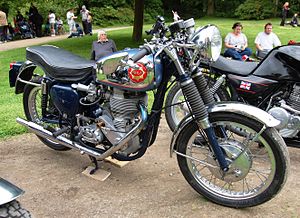 1956 DBD34 Gold Star (modified) | |
| Manufacturer | BSA |
|---|---|
| Production | 1939–1963 |
| Predecessor | 1936–1939 BSA Empire Star |
| Successor | 1971–1973 BSA B50[clarification needed] |
| Class | Standard |
| Engine | 348 cc (21.2 cu in) (B32) 496 cc (30.3 cu in) (M24), 499 cc (30.5 cu in) (B34) alloy air cooled OHV 2V pushrod single |
| Bore / stroke | M24 82 mm × 94 mm (3.2 in × 3.7 in) B32 71 mm × 88 mm (2.8 in × 3.5 in) B34 85 mm × 88 mm (3.3 in × 3.5 in)[clarification needed] |
| Compression ratio | M24 7.75:1 (petrol) 12.5:1 (dope/alcohol[clarification needed]) ZB32 6.5, 8:1, 9:1, 13:1 B32 6.8:1, 7.5:1, 8:1, 9:1, 11:1 |
| Top speed | 110 mph (180 km/h) (varies by model and options)[1] |
| Power | Approx. 18–27 hp (13–20 kW) (M24 and B32) 34–42 hp (25–31 kW) (M34) (varies by model and options)[2][1] |
| Ignition type | Magneto |
| Transmission | Wet multiplate clutch, 4-speed, chain |
| Frame type | Steel full duplex |
| Suspension | Front: telescopic fork, Rear: rigid from 1939, plunger from 1954; swinging arm |
| Brakes | Front: single sided 7" competition models, and M24. 8" or full-width 190 mm for touring and racing models [clarification needed] drum cable actuated, hydraulic, Rear: 7" Drum, rod |
| Tyres | Front: 3.0×19" Rear: 3.5×19" |
| Wheelbase | 56 in (1,400 mm) |
| Seat height | 30.5 in (770 mm) |
| Weight | 380 lb (170 kg)[3] (dry) |
| Fuel capacity | 4 imp gal (18 L; 4.8 US gal) |
| Fuel consumption | 45 mpg‑imp (6.3 L/100 km; 37 mpg‑US)[3] |
| Related | BSA B33 BSA Rocket Gold Star |
The BSA Gold Star is a motorcycle made by BSA from 1938 to 1963. They were 350 cc and 500 cc single-cylinder four-stroke production motorcycles known for being among the fastest bikes of the 1950s. Being hand built and with many optional performance modifications available, each motorcycle came from the factory with documented dynamometer test results, allowing the new owner to see the horsepower (bhp) produced.[4]
The Gold Star was almost continuously developed over its lifetime by BSA's engineers and riders, who improved its capabilities and increased output from its essentially simple push-rod petrol engine than had been thought possible[by whom?]. It was highly successful across almost all areas of motorcycle sport for well over a decade and is still regarded as a design icon of its era.[3]
